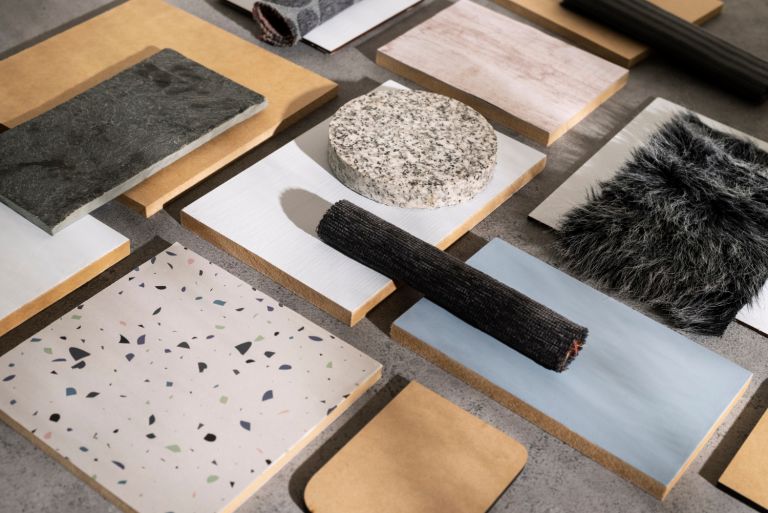When it comes to interior design, choosing the right color palette for your home can be one of the most exciting—and daunting—tasks. A well-chosen palette not only reflects your personality but also sets the mood and flow of your living space. At Greenberg Design, we believe that the right colors can transform a house into a home, making each room feel welcoming, functional, and uniquely yours. So, let’s explore some key steps and tips for selecting the perfect color scheme that suits your style and enhances your space.
1. Start with Inspiration: Look for What Speaks to You
Before diving into paint samples, take a moment to gather inspiration. Look at design magazines, Pinterest boards, nature, your favorite art pieces, or even the clothes you love to wear. Your personal preferences can tell a lot about what colors make you feel comfortable and happy.
I always tell my clients to create a “mood board.” This could be a digital collection of images or a physical board with fabric swatches, photos, and paint chips. Having a visual collection helps you identify patterns in your color preferences and provides a starting point for your palette.
2. Understand Color Psychology: Setting the Mood
Color has the power to influence our moods and perceptions, so it’s important to think about how you want each room to feel. Here’s a quick rundown of common colors and their psychological impact:
- Blues: Calm and serene, perfect for bedrooms and bathrooms.
- Greens: Fresh and natural, ideal for creating a relaxing atmosphere in living rooms or home offices.
- Yellows: Energizing and cheerful, great for kitchens and dining areas.
- Reds: Bold and stimulating, often used as accent colors in social spaces.
- Neutrals (beige, gray, white): Versatile and timeless, providing a backdrop that allows other elements in the room to shine.
Pro Tip: Soft, muted tones create a calming effect, while vibrant, saturated hues add energy. Decide what mood you want to set in each room before choosing your color palette.
3. Consider the Fixed Elements: Work with What You Have
If you’re not starting from scratch, take a look at the existing elements in your home that won’t change—such as flooring, cabinetry, countertops, or large furniture pieces. Your color palette should complement these fixed elements rather than clash with them.
For example, if you have dark wood floors, a lighter wall color can create contrast and balance. Alternatively, if your kitchen features a bold countertop, consider choosing a neutral shade for the surrounding walls to let the countertop remain the focal point.
4. Use the 60-30-10 Rule: Creating Balance in Every Room
One of my go-to strategies for creating a cohesive color scheme is the 60-30-10 rule. Here’s how it works:
- 60%: Your dominant color, typically used on walls and large furniture pieces.
- 30%: A secondary color that complements the dominant color, often used on upholstery, curtains, or smaller furniture.
- 10%: An accent color that adds a pop of interest, used in accessories like pillows, artwork, or decorative objects.
This rule helps ensure that your room has a balanced look without feeling too monochromatic or overly chaotic.
5. Test Colors Before You Commit: Samples Are Your Best Friend
I can’t stress this enough: always test paint colors in your actual space before making a final decision. Lighting conditions can dramatically affect how a color appears. What looks perfect in a showroom might appear too dark or washed out in your home’s lighting.
Here’s what I recommend:
- Buy sample-sized paint cans of a few different shades.
- Paint small swatches on different walls to see how the color looks throughout the day.
- Observe the colors in natural light as well as artificial light at night.
This simple step can save you from making costly mistakes and ensure that you love the colors once they’re up on the walls.
6. Create a Flow from Room to Room: Cohesiveness is Key
When designing a color palette for your entire home, it’s important to create a sense of flow between rooms. This doesn’t mean every room needs to be painted the same color, but there should be a harmonious transition as you move through the spaces.
How to Achieve Flow:
- Choose a base color (usually a neutral) that runs through the main areas of the house, like hallways and living spaces.
- Use complementary colors in adjoining rooms to create visual interest while maintaining a cohesive look.
- Repeat accent colors from one room to another to tie the spaces together.
For example, if you have a navy accent wall in the living room, you might carry hints of navy into the adjacent dining room with navy upholstered chairs or a navy area rug.
7. Don’t Forget the Ceilings: The Fifth Wall
The ceiling is often overlooked, but it plays a crucial role in your room’s overall aesthetic. While white is a popular choice, you can use other colors to make a statement. A light-colored ceiling can make the room feel taller and more open, while a darker color can create a cozy, intimate atmosphere.
In some cases, matching the ceiling color to the wall can blur the boundaries of the room, giving it a seamless, expansive look. This technique works particularly well in small spaces or rooms with low ceilings.
8. Use Nature as Your Color Guide
If you’re feeling stuck, look outside for inspiration. Nature provides some of the most beautiful and balanced color combinations. Think of the colors found in a beach setting (soft blues, sandy beige, whites) or a forest (greens, browns, and earthy tones). These combinations can translate into a calming and organic color palette for your home.
9. Keep Your Personal Style at the Forefront
Finally, remember that your home is your sanctuary. While trends are fun to explore, your color palette should reflect your personal style and preferences. Whether you love bold, vibrant hues or prefer a serene, neutral palette, choose what makes you feel comfortable and happy.
Ready to Choose Your Perfect Palette? Let’s Get Started!
Choosing the right color palette for your home can feel like a daunting task, but with a bit of planning and inspiration, it becomes an exciting part of the design process. At Greenberg Design, we specialize in creating spaces that harmonize with your lifestyle and taste. Whether you’re looking to refresh a single room or the entire house, we’re here to help you find the perfect colors that make your space truly shine.
Ready to dive into the world of color? Contact us today, and let’s start crafting a palette that speaks to you!






